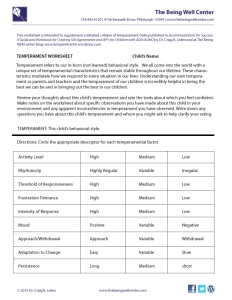A key goal in effective treatment for Attention Deficit Disorder should be to understand our temperament and the temperament of the children we live and work with.
Understanding the concept of temperament and applying that knowledge to ourselves as parents and teachers and to those around us helps us to better understand behavior…struggles, failures, and successes.
Understanding FRUSTRATION TOLERANCE
Frustration Tolerance refers to the level of difficulty we are able to experience before we become frustrated. Frustration tolerance ranges from high to low.
Those of us who have a high frustration tolerance are able experience an awful lot of difficulty before we feel frustration.
Others of us who have a low frustration tolerance become frustrated very easily.
The child with a high frustration tolerance may be able to deal with repeated struggles and failures in the classroom without experiencing significant frustration.
The child with a very low frustration tolerance, however, can be quick to experience frustration when asked to perform tasks of only moderate difficulty. This, in turn, sets him up for repeated struggles and can turn into negativity towards school and other learning situations.
 Upcoming blog posts will discuss the other 9 Temperamental Traits that make you and your child unique. Follow along with this Being Well Center | Temperament Worksheet designed to help you pinpoint where your or your child’s temperament trait falls on the continuum. Catch up on previous posts about Activity Level, Rhythmicity, and Threshold.
Upcoming blog posts will discuss the other 9 Temperamental Traits that make you and your child unique. Follow along with this Being Well Center | Temperament Worksheet designed to help you pinpoint where your or your child’s temperament trait falls on the continuum. Catch up on previous posts about Activity Level, Rhythmicity, and Threshold.
Don’t forget to follow us on Facebook and join a community of people interested in getting the facts straight with compassionate support for ADD/ADHD!


Pingback: Understanding Temperament: Intensity | The Being Well Center
Pingback: Understanding Temperament: Approach-Withdrawal | The Being Well Center
Pingback: Understanding Temperament: Adaptability | The Being Well Center
Pingback: Understanding Temperament: Persistence | The Being Well Center
Pingback: Temperament: Success is in Understanding the Mix | The Being Well Center